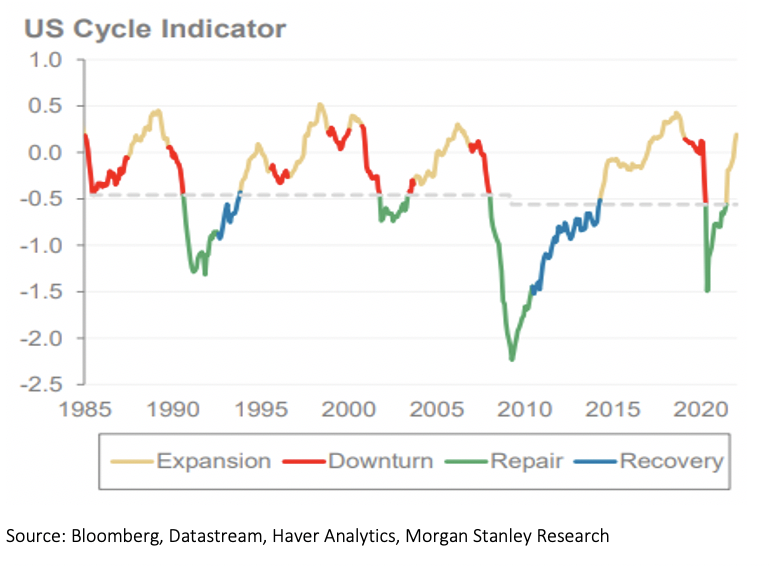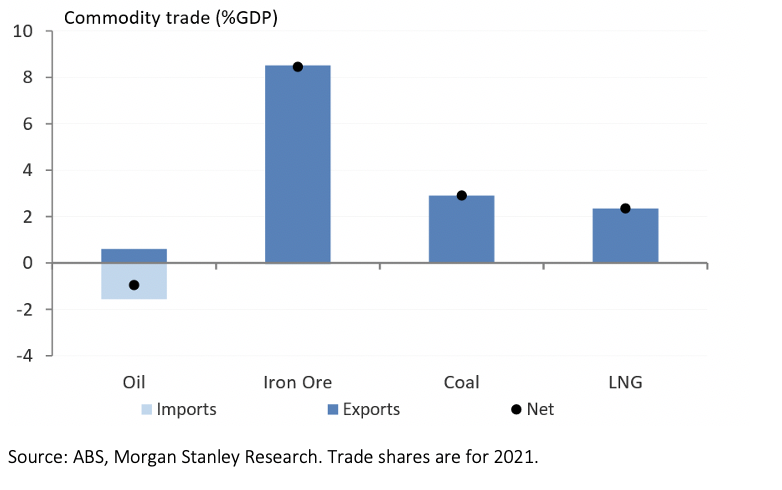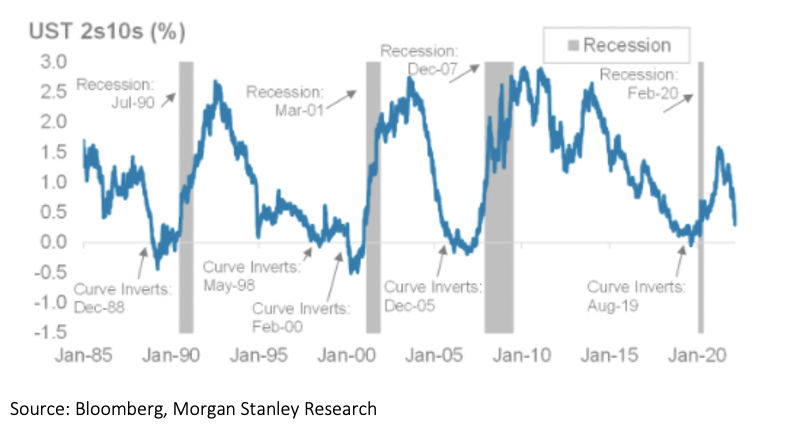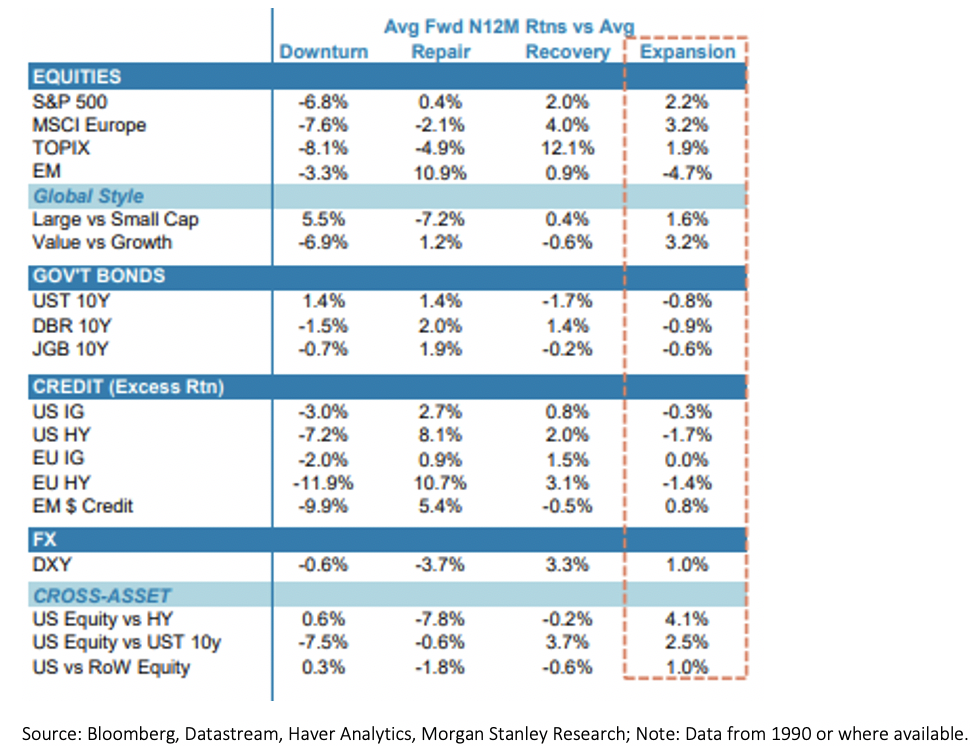Morgan Stanley’s playbook for investing in 2023 and beyond
Short-term events have been put under the microscope recently. Conflict, supply-chain shortages and inflation have all contributed to inevitable rate hikes and rampant volatility in markets. But while they are stealing headlines for now, not all of these topics will remain important beyond 2023. Accordingly, long-term investors must remain disciplined in their outlook and continue thinking about what the most important topics will be 5 years down the track.
With this in mind, Andrew - one of our readers - wrote in with the following thoughts:
"A second suggestion would be to look forward to see what the investment universe might look like in say, 2023 and consider how the possible outcomes would play out for various groups of stocks, sectors, commodities etc. For example, should we be looking at a recessionary environment, what does history tell us about the sectors that we should avoid. How does gold, and oil react? My reading tells me that far too often we read about these things well after the event. In my opinion, a thorough investigation into this area would better prepare investors for what lies ahead."
Accordingly, we enlisted help from three of the country's top macroeconomists and portfolio strategists and asked them to provide insight into their longer-term market views. We discuss the most important topics investors should keep in mind, what this might lead to in terms of the macro environment and ultimately, what this means for investors.
In the first wire of this collection, I reached out to Alexandre Ventelon, Head of Research and Investment Strategy at Morgan Stanley Wealth Management. He has over 16 years of experience in portfolio strategy and asset allocation.

Make sure to follow my profile to see future responses from
- Shane Oliver, AMP Capital
- Scott Haslem, Crestone
What are the main topics you think will continue to be pertinent for investors going into 2023 and beyond?
Though the news flow is currently pointing at some progress, geopolitical concerns in Europe are unlikely to be resolved quickly and in particular, we don’t expect currently elevated commodity prices to decline to the levels they were at pre-conflict in the near term. As many of these commodity markets were already in deficit, it is likely elevated pricing and associated inflation pressures will remain for the foreseeable future. For instance, the oil market will probably remain in deficit throughout the year at a time when inventories are already at multi-year lows and Brent prices are expected to peak at US$120/bbl by 3Q22 and average US$100/bbl in 2023.
Fig. 1: Since end-2020, the oil price has more than doubled, wheat has experienced a ~65% price increase, while copper and soybeans have also seen ~30% price hikes

We believe there are three main channels in which the current geopolitical developments in Europe will likely flow through to the global economy and financial markets including:
- Market sentiment and a ‘flight to quality’;
- Higher energy prices and higher inflation; and
- Reduced global growth expectations.
In this context, the most critical issue for investors is to monitor central bank policies in the face of fading, but still very strong inflation.
Fig. 2: Rapidly progressing towards the later stages of the expansion phase of the US economic cycle

By tightening appropriately, central banks will allow inflation pressures to subside whilst maintaining economic growth momentum. However, if tightening becomes too strong we could expect consequent demand destruction and tighter financial conditions, which would likely put an early end to this cycle. In addition, not enough tightening could also mean inflation pressures increase, and as a consequence, central banks respond down the track with sharper increases in rates in a short period of time - potentially leading to an economic recession under this scenario.
Additionally, within this broader context, other key uncertainties include
- Consumers: In most countries, they are in good shape: unemployment is low, wages are rising and savings rate are elevated. Will they continue to spend?
- Corporations: Margins are heavily affected by rising input costs, while macro momentum is fading. Capex intentions were extremely high and a key driver of the strong growth in our forecast: will these still eventuate in this environment?
What do you believe the domestic macro environment will look like as a result of these topics, and how might this compare globally?
We expect it is likely Australia will outperform most Developed Markets this year and next year given strong economic momentum, the nation’s position as a commodity exporter, lower inflation pressures, as well as a more accommodative RBA.
One key impact of the recent geopolitical developments will be on inflation in Australia, with Morgan Stanley revising its headline inflation forecast from 2.3% to 3.6% in the fourth quarter (peaking at 4.4% mid-year) and core forecast from 2.6% to 3.4% for 2022. However, we expect inflation to normalise into 2023 and towards the top of the RBA target inflation (Headline inflation at 3.0%, Core CPI at 2.9%), under the combined effects of:
- Rapidly normalising supply chains;
- Supply-demand mismatch reversion in main commodity markets;
- Return of foreign travellers weighing on wage inflation; and
- Property sector cooling off.
In addition, on the growth side, higher commodity costs will represent a tax on the consumer in Australia as well – Morgan Stanley estimates that the current oil futures curve implies a A$12bn increase in fuel spending by households this year (0.6% of GDP; 0.9% disposable income; ~A$1100 per household) - assuming no resulting change in activity. While this is a meaningful headwind, the very tight labour market (unemployment rate of 4.0%) and elevated excess savings (~A$250bn) provide an important cash flow buffer to households. Additionally, Australia's position as a commodity exporter means the broader economy should see a net positive income impact (with miners and government benefiting).
Net-net, we see only a small GDP impact, and our full-year 2022 and 2023 forecasts at 4.5%Y and 3.5% respectively remains above consensus, trend, and peers (i.e.: 3.7% and 2.8% forecast for the G10 economies).
It is also worth noting the government is a net beneficiary of the recent commodity moves with Treasury estimating a ~A$3.5bn budget tailwind for every 10% increase in commodity prices. Given the Federal Election is due in May, we expect much of this benefit will be transferred to households and expect specific cost of living measures announced at the Budget on 29 March.
Fig. 3: Australia is a net exporter of commodities

What are the data points you are paying closest attention to when it comes to monitoring the macro outlook?
Given we believe a high priority for central banks is to keep inflation under control to avoid a premature end to the cycle, it is important to monitor the key related indicators.
In particular, it is essential to keep a strong focus on the key determinants of inflation on the headline side (energy, food, metals), as well as on the core side (wages, rents). We will also be watching leading supply chain indicators including as provided in the PMI surveys.
Similarly, it will be necessary to monitor leading economic indicators such as PMIs, LEIs (Leading Economic Indicators) and consumer confidence. We will also be watching business confidence, capex intentions and earnings revisions.
With regards to the risk of a potential early end to this economic and market cycle, late cycle/recession indicators – in particular, the unemployment rate, credit spreads, yield curve slope (especially the spread between 10-year and 2-year yields in the US), and recession models – are also important to monitor.
Fig. 4: Yield curve inversion potentially approaching, the key economic recession indicator – but with a long lead time: the average gap since 1985 is 19 months

What does your outlook mean for portfolio allocation? How would particular asset classes (equities, bonds, etc.) perform in that environment?
In aggregate, we see a relatively mixed environment for most asset classes in the short term; The 1–2-year outlook will be largely dictated by i) what happens in Eastern Europe; ii) the appropriateness of key central bank (and government, to a certain extent) responses in the face of rising inflation pressures; and iii) flow on impacts on economic growth.
If, as per our base case, there is no US “hard landing”, we would expect to revert to a mid to late cycle environment - i.e. the expansion phase of the cycle - with strong economic growth, strong inflation, rising interest rates, and low unemployment.
This period has historically been a favourable one for risk asset returns: i.e. equities, Value and commodities.
Fig. 5: Expansion phase of the economic cycle is traditionally a strong period for risk assets

What does your view imply for valuations across particular sectors and the broader market?
We believe there is a solid "case for" continued Australia resilience despite potentially heightened volatility settings.
Australia has been our preferred market since February on the back of:
- More resilient GDP growth;
- Strong commodity prices;
- Attractive yield: after a period of dividend rebuild post-Covid, the Australian market is now yielding ~4.4%;
- A more accommodative RBA keeping monetary conditions relatively loose for an extended period of time; and
- A more defensive quality bias, especially versus surrounding regional markets in Asia.
Furthermore, the recent equity market de-rating has restored more attractive valuations. In aggregate at around 15x 12M forward, the market is now within the historically observed P/E range when 10-year treasury yields were between 2-3%.
We remain cautious on US equities. Morgan Stanley’s US equity strategy team has been suggesting 18x 12M EPS is "fair value" based on a 10-year Treasury yield of 2.1% and an equity risk premium (ERP) of 350bps. However, given the current risks in Europe and the associated higher volatility, the ERP appears too low at the moment and could easily overshoot to the upside by ~100bps. Using such an adjustment yields a P/E closer to 15x which suggests an S&P 500 of 3500 assuming earnings aren’t impacted. Given the most recent closing price of 4412, the risk/reward remains poor over the next several months.
What lessons must investors keep in mind when it comes to making long term investment decisions through this period?
As highlighted in our most recent capital market assumptions publication, valuations remain the key driver of asset class returns over the long run (7 years plus). With this recent long-awaited equity market adjustment, increased value in Europe, Emerging Markets and Japan is evident given these regions are now trading below their long-term averages. ‘Fair’ Value has also been restored in Australian Equities after the recent de-rating. However, US equities remain too expensive at this stage to offer a strategic entry point - although if our US bear case eventuates, they would become a lot more compelling.
Another key consideration is the substantial risk in holding a one-sided portfolio in terms of factor exposure. Factor exposures need to be reassessed frequently in light of the macro and policy outlook. With the end of ‘free money’ - which has been driven by faster than expected progress on the growth side and unadapted supply chains pushing inflation pressures higher - the most speculative and expensive parts of the markets have had to adjust.
This could have further to go if economic growth remains above trend and yields keep rising.
But again, it needs careful monitoring: in particular, a deep fall in economic activity would certainly reverse flows abruptly towards growth style investing.
The final consideration is the importance of diversification. In particular, we often stress the role of maintaining allocations to the three main ‘ballasts’: i.e. foreign currency, government bonds and gold, noting that the three might not all work at the same time. With rising inflation pressures and rising bond yields, government bonds have offered limited protection since the beginning of the recent events in Eastern Europe. Similarly, the Australian dollar hasn’t weakened in line with historical reactions to a risk-off environment. Gold however has played its part as a safe haven asset.
Bonds haven’t exhibited safe haven attributes to date

Specialist advice from Morgan Stanley
Morgan Stanley Australia focuses on providing individuals and institutions with specialist strategic advice and then helping implement these strategies through superior investment execution. For more insights from Alexandre, follow him here.
4 topics
3 contributors mentioned

